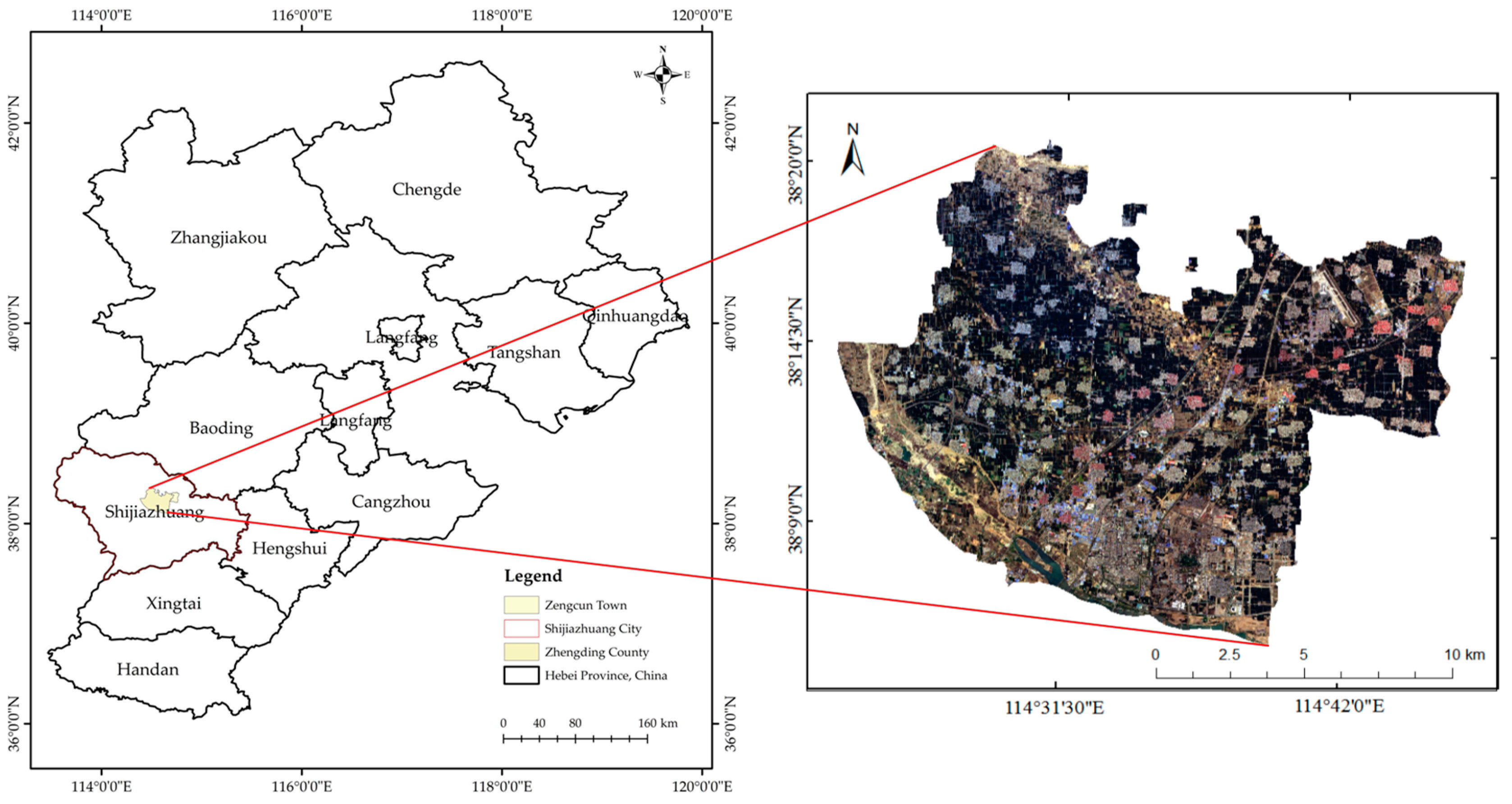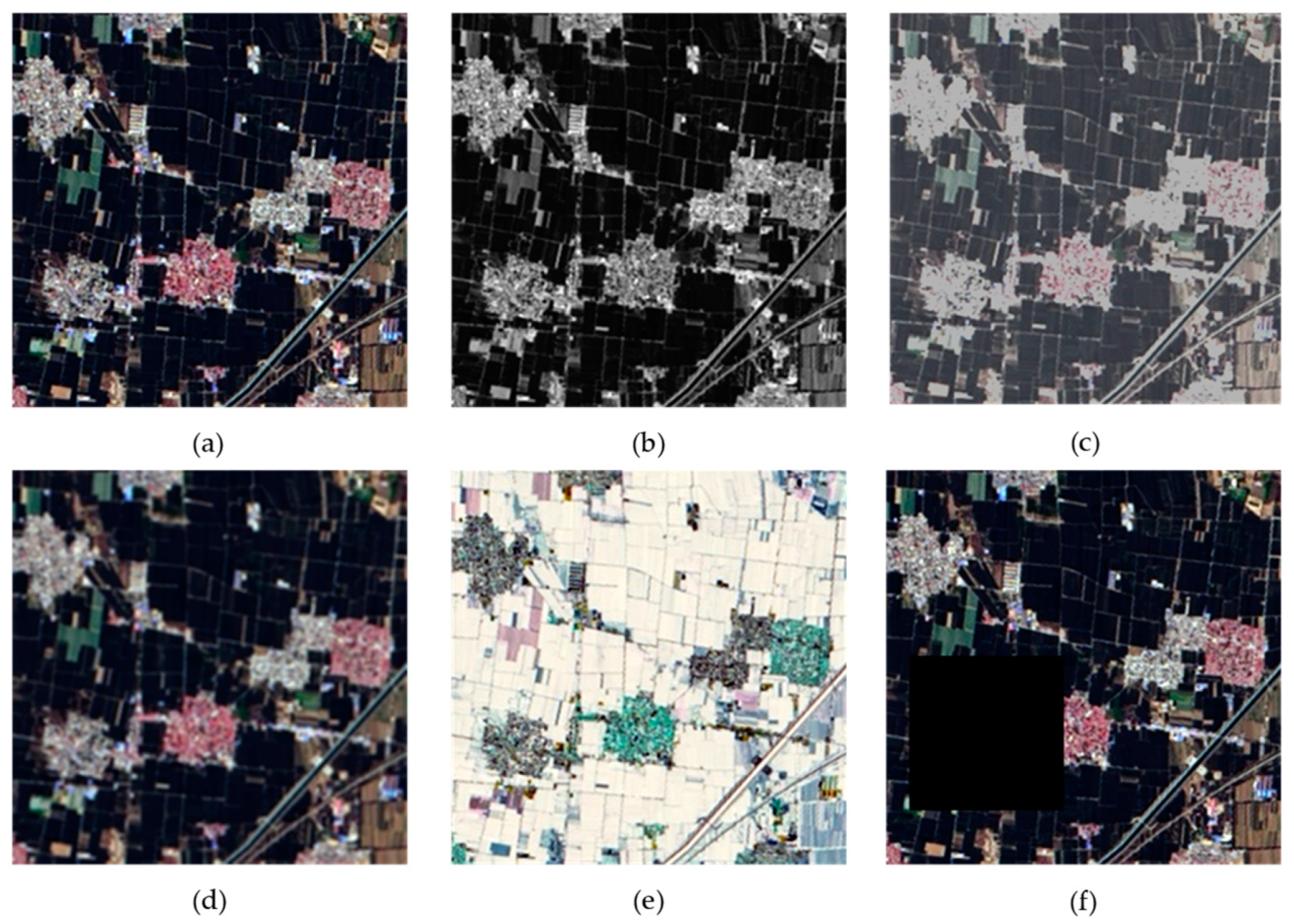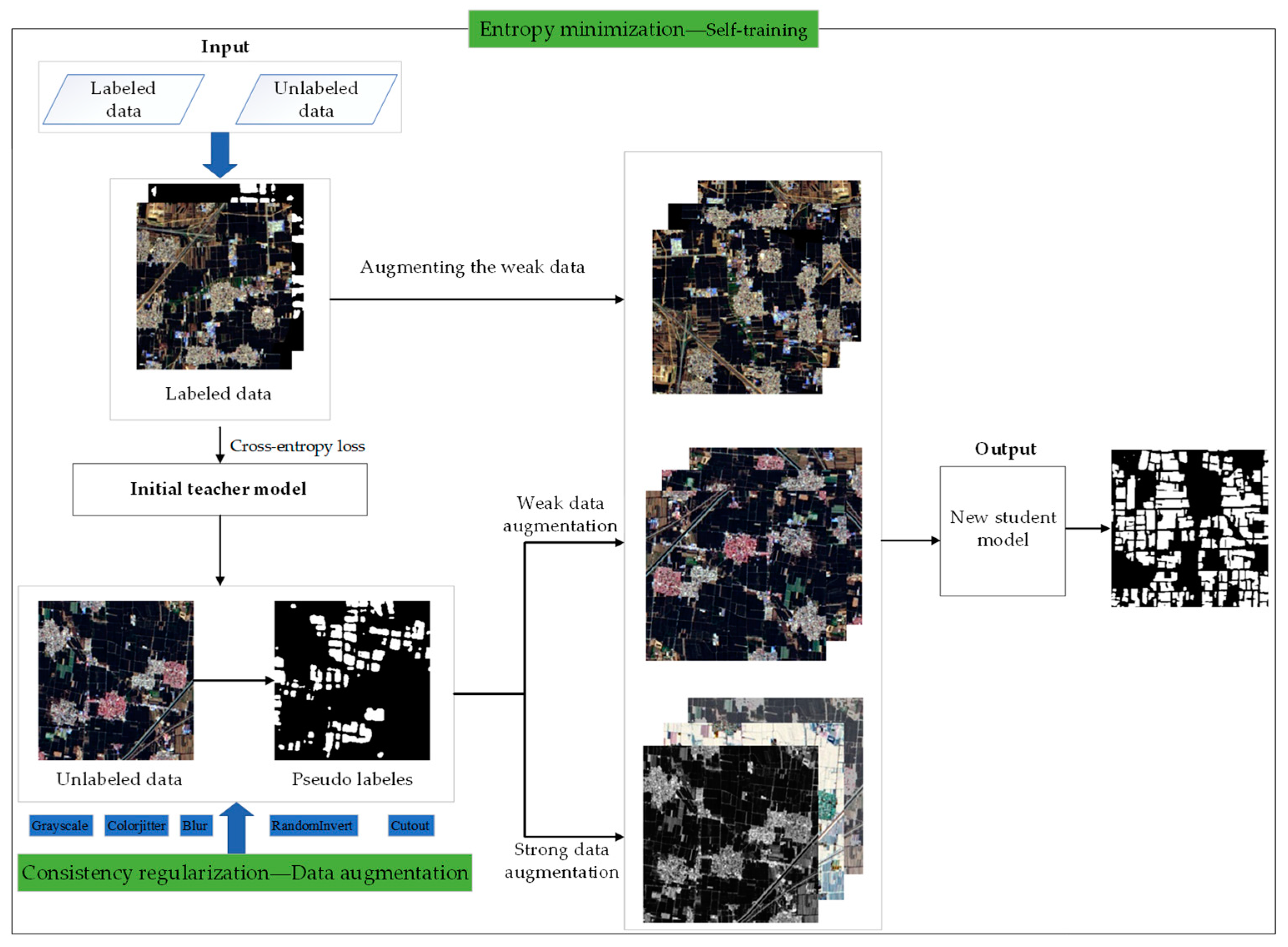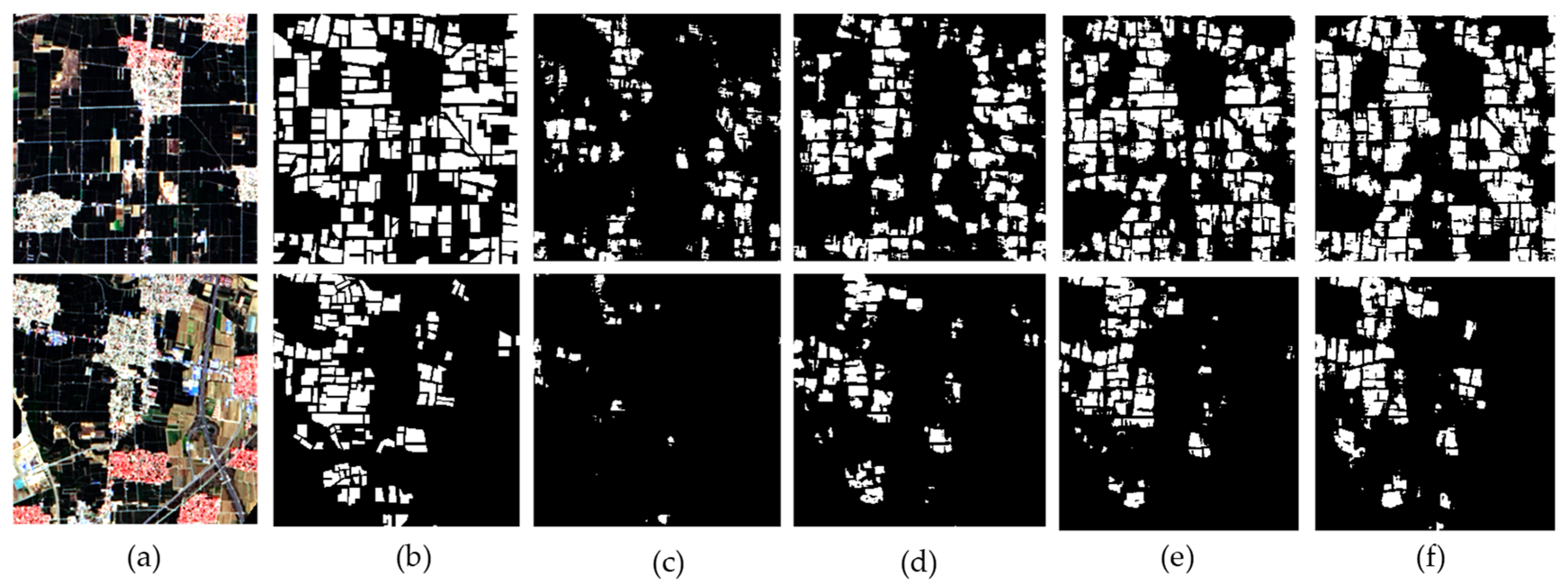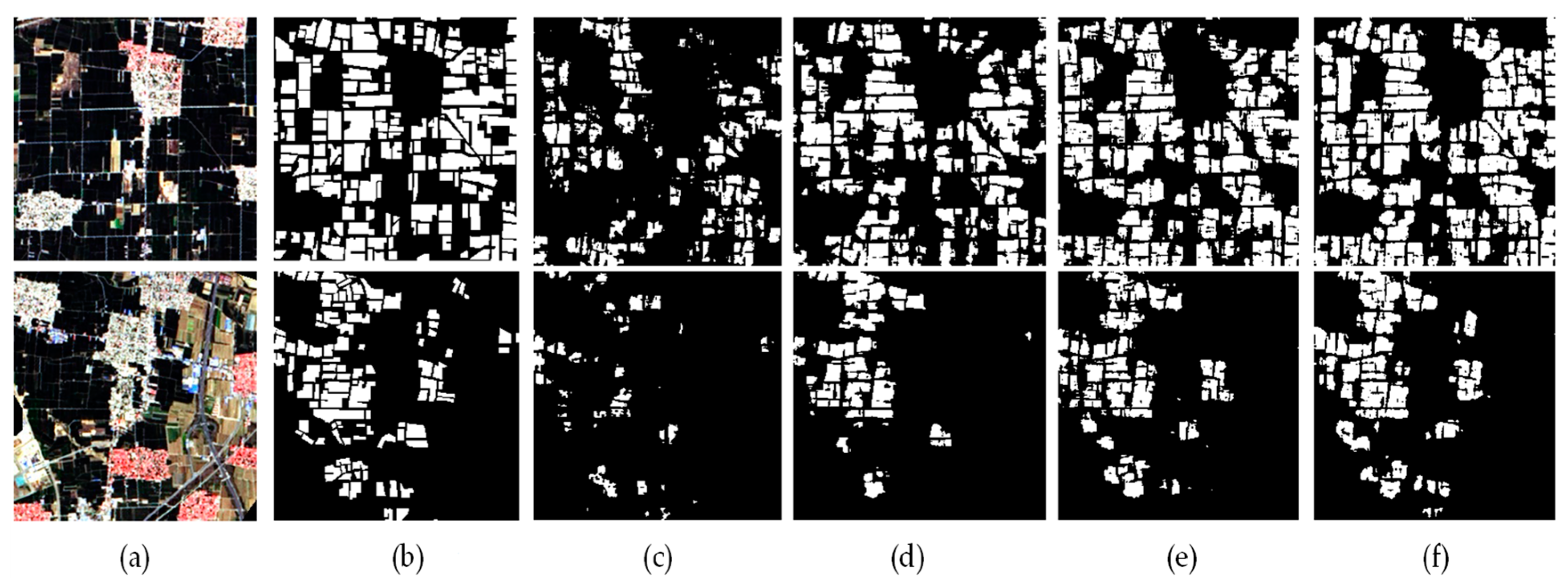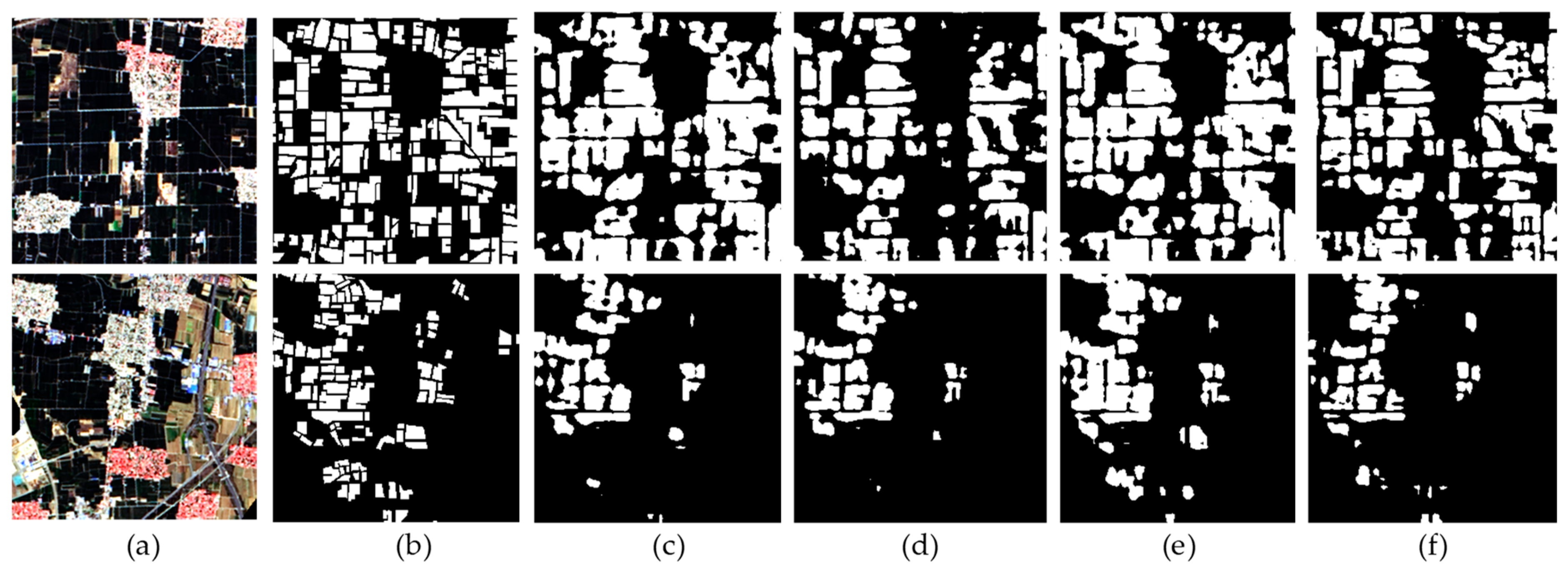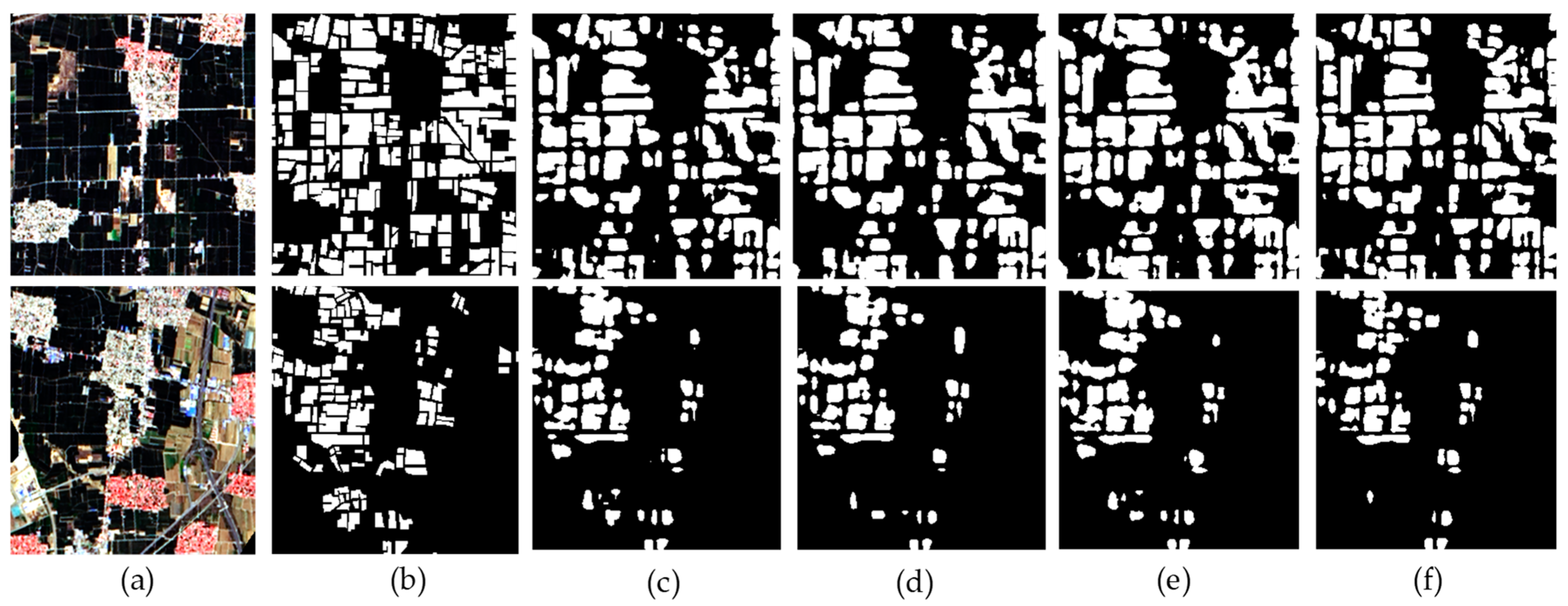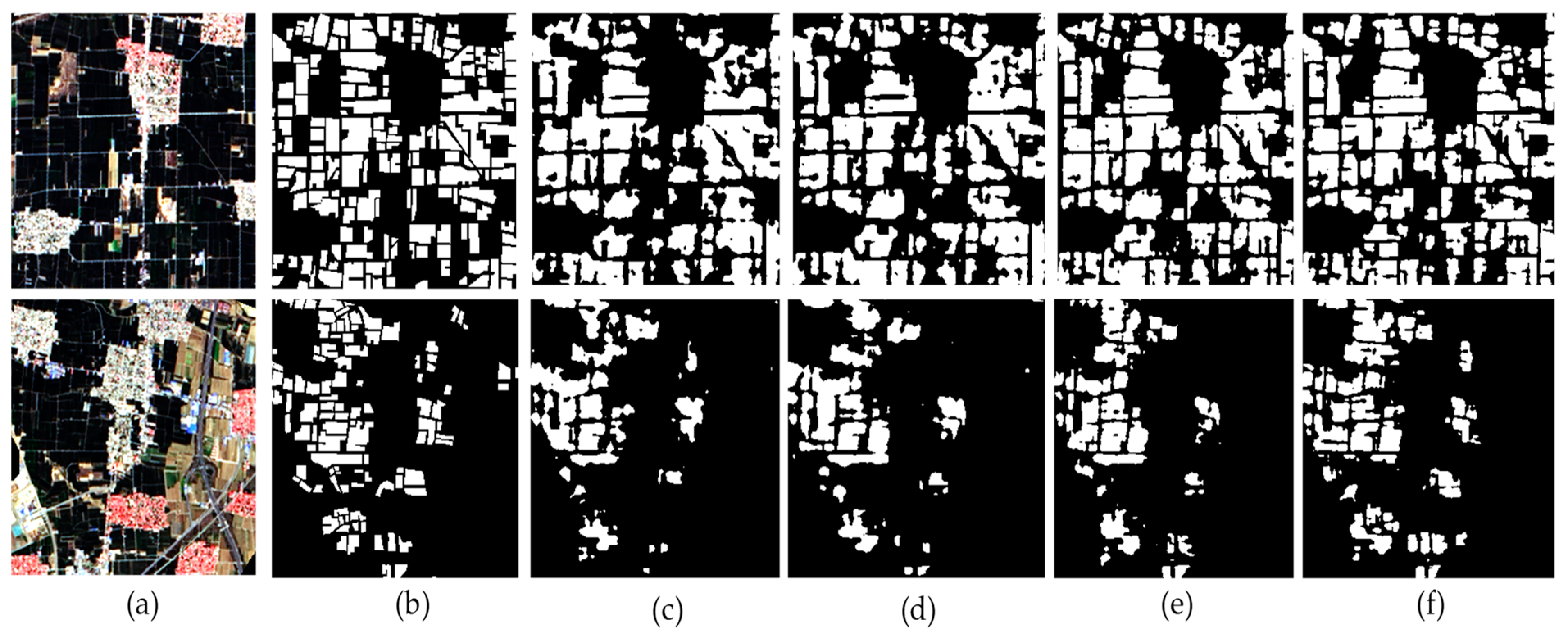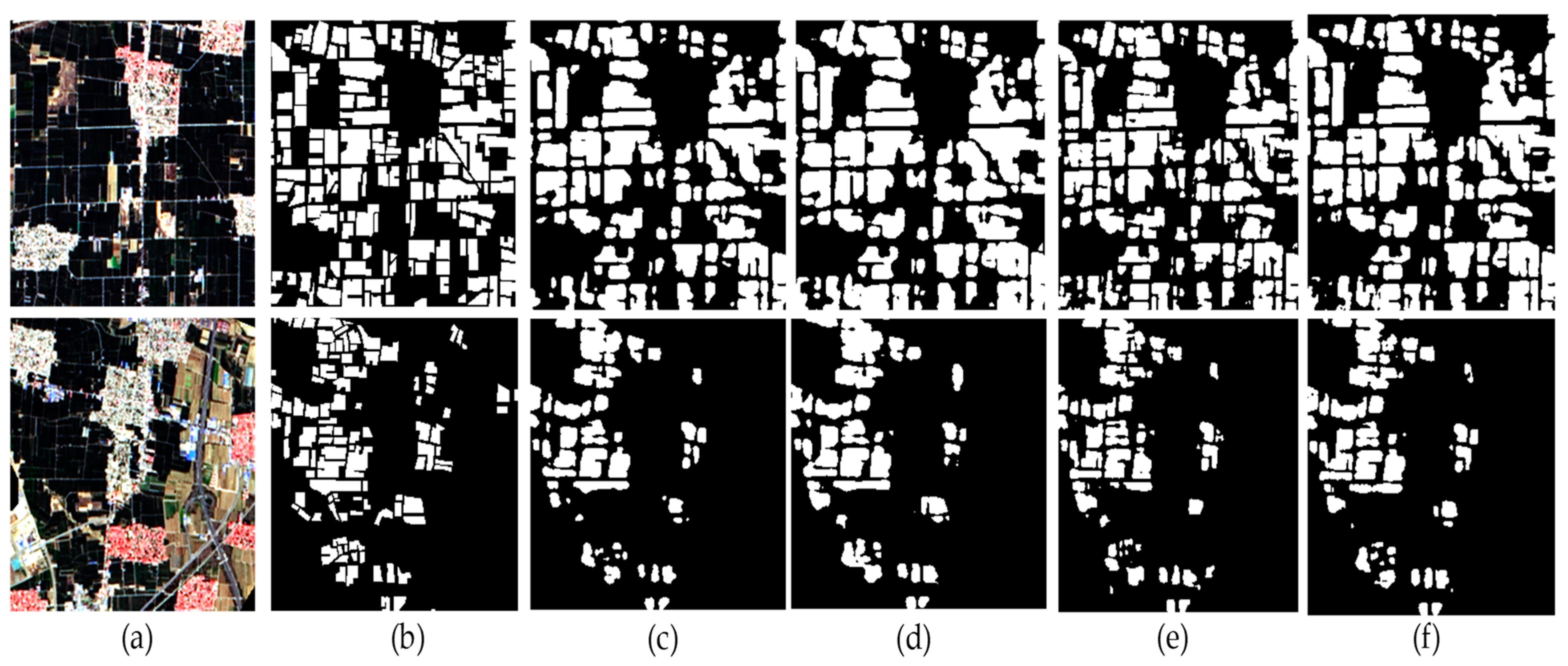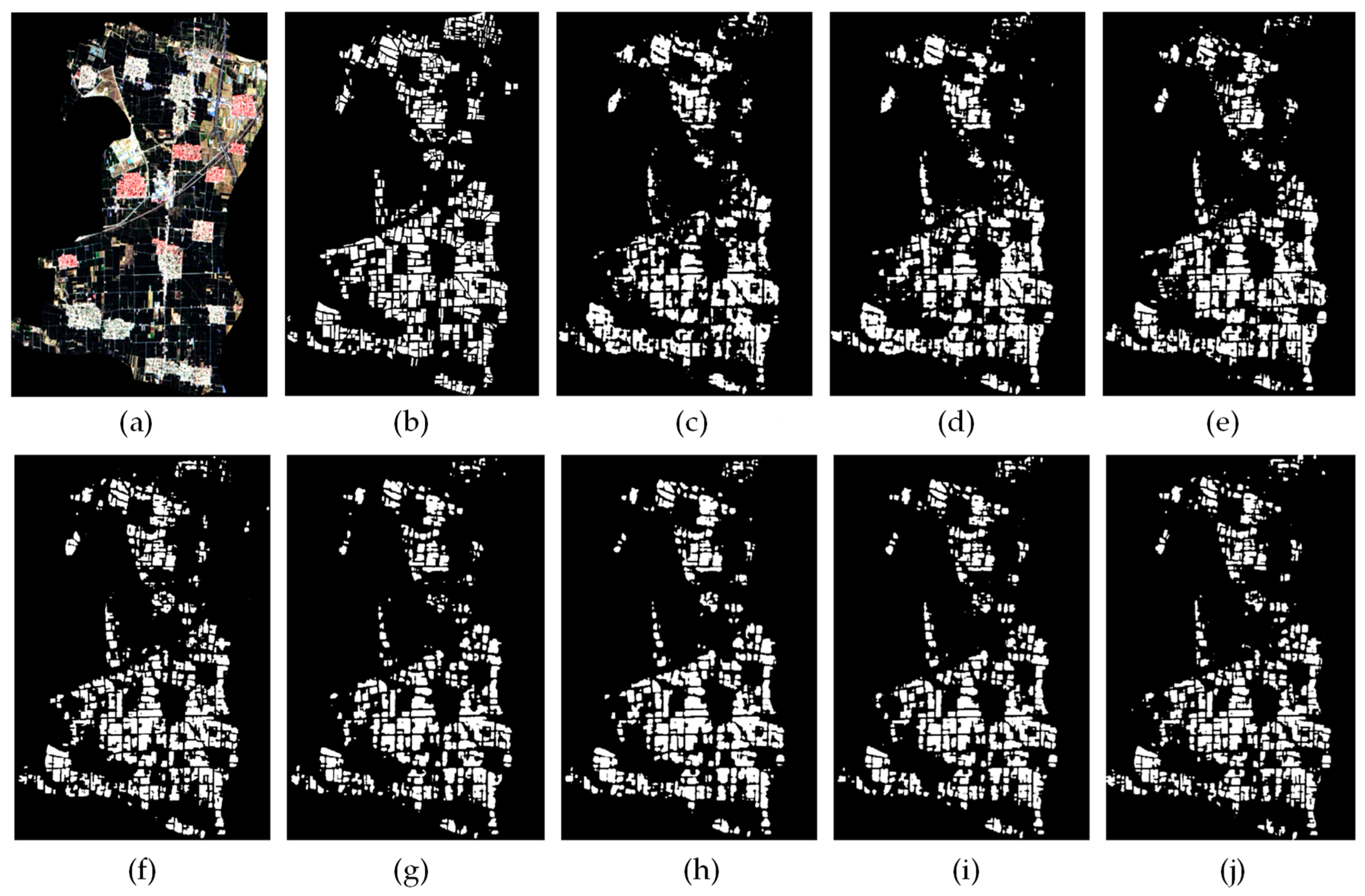1. Introduction
Semantic segmentation is a fundamental task in the field of computer vision, and it has made significant progress in many application areas [
1,
2,
3]. Fully supervised semantic segmentation learns to assign pixel-level semantic labels by generalizing from a large number of densely annotated images. Despite rapid progress, the cost of manually annotating pixels is much higher compared to other visual tasks such as image classification and object detection. Reliable pixel-wise segmentation annotations are typically only available for a few classes and images, making fully supervised semantic segmentation challenging for tasks involving diverse objects. To further simplify the process of acquiring high-quality data, semi-supervised semantic segmentation has been proposed, which learns models from a small number of labeled images and a large number of unlabeled images to achieve the final segmentation goal. Many researchers have applied semi-supervised semantic segmentation to crop extraction. Casado-García et al. [
4] used a pseudo-label semi-supervised learning method combined with a semantic segmentation network to segment natural color images of vineyards captured by cameras for plant yield monitoring. Zheng et al. [
5] improved segmentation accuracy with a small number of labeled data by using a semi-supervised adversarial semantic segmentation network for building extraction on three different resolution datasets (WBD, MBD, and GID). Mukhtar et al. [
6] proposed a semi-supervised method based on cross-consistency for semantic segmentation of RGB images captured by drones and further counted the extracted plant clusters, providing insights for studying other crops (such as rice and maize) using a small number of labeled images. In the field of semi-supervised semantic segmentation, two widely used forms of semi-supervised methods are entropy minimization and consistency regularization [
7].
Self-training [
8,
9], also known as self-supervised learning, is a semi-supervised learning technique where a model iteratively generates pseudo-labels for unlabeled data and then uses these pseudo-labeled samples to retrain itself. It aims to improve the model’s accuracy by iteratively refining its own predictions, often by considering high-confidence predictions as pseudo-labels. Zhu et al. [
10] achieved optimal performance with less supervision using the self-training semi-supervised method on the Cityscape, CamVid, and KITTI datasets. Feng et al. [
11] proposed a dynamic self-training and class-balanced curriculum algorithm for semi-supervised semantic segmentation. They achieved robustness to pseudo-label noise in self-training by weighting the pixel-wise loss based on predicted confidences and providing a pseudo-label curriculum to gradually label all unlabeled data, demonstrating good performance on PASCAL VOC 2012 and Cityscapes. Zoph et al. [
12] compared self-training with ImageNet pre-training and revealed the universality and flexibility of self-training. These studies serve as typical examples of self-training methods. However, this approach also has certain limitations. If the teacher model trained based on labeled data contains errors, it can lead to erroneous results in the subsequent student model.
Recently, methods based on consistency regularization have been proposed, which rely on the fact that unlabeled and labeled data share the same distribution. Therefore, these methods aim to train models that have consistent and reliable predictions for both labeled and unlabeled data. One widely researched approach is to use different unlabeled images under different transformations as inputs to the model and enforce consistency loss on the predicted masks. In consistency regularization methods [
13,
14], consistency is enhanced by augmenting input images, feature representations, and networks to ensure consistency with various perturbations, such as input perturbations, which involve perturbing unlabeled data [
15,
16]. Based on the clustering assumption, data points with different class labels are separated from each other, while similar data points have similar outputs. Therefore, if an unlabeled data point is perturbed and consistency constraints are enforced on the predicted masks of the perturbed images, the predicted results should not change significantly. Common transformations include data augmentation techniques such as adding noise, cropping, and scaling [
17], as well as methods like CutMix [
18] and ClassMix [
19]. These form the basis of consistency-based methods and many self-supervised learning methods, all of which focus on leveraging unlabeled data. For example, the Π-model parameterizes input samples with different noises and adds a regularization term to reduce the difference between the outputs of the perturbed samples and the original inputs. Temporal ensembling [
20] and mean teacher [
21] involve ensemble learning, using exponentially moving average (EMA) weights to improve the quality of labels for perturbed samples. CCT (cross-consistency training) [
22] is a semi-supervised semantic segmentation method based on cross-consistency, which applies perturbations to the input of the encoder instead of directly perturbing the input, exploring the application of perturbations at different network layers in the segmentation network. Interpolation consistency training (ICT) achieves a modification in the perturbation method by using a mixture with another unlabeled sample instead of adding random noise, which is considered more effective in dealing with low-margin unlabeled points. Berthelot et al. [
23] further propose sharpening artificial labels for unlabeled data and using MixUp to mix labeled and unlabeled data.
Generative adversarial networks (GANs) are generally utilized for tasks related to generative modeling, where they generate data that are similar to the training data. They indirectly might benefit semi-supervised learning but not as a direct supervision signal, are not easy to optimize, and may encounter mode collapse issues [
24]. Pseudo-labeling [
25] is a combination of entropy minimization and consistency regularization, which relies on the assumption that pseudo-labels generated by a teacher model can benefit the training of a new model. FixMatch [
26] achieves consistency training by applying strong data augmentation (Cutout, CTAugment, and RandAugment) to the unlabeled loss and input for pseudo-label generation, encouraging the outputs of two augmented inputs to remain consistent. As an extension of FixMatch, PseudoSeg [
27] uses weak and strong augmentations on an unlabeled image and uses the predictions of the weakly augmented image as pseudo-labels for the strongly augmented image. This method generates pseudo-labels using only the image itself.
In conclusion, semi-supervised learning offers a significant reduction in the annotation process, resulting in resource savings in terms of manpower and materials. Nevertheless, it can be found that the performance of these semi-supervised semantic methods can be limited by the quality and quantity of the labeled data available. Inaccurate or inconsistent annotations can hinder the learning process and result in suboptimal segmentation performance. In addition, some methods may require complex architectures or training procedures, which can make them computationally expensive and difficult to implement in real-world applications. It is necessary to reduce the reliance of segmentation methods on high-quality pseudo-labels while simultaneously minimizing the number of iterative rounds required to generate such labels. Currently, most related studies have focused on publicly available datasets, with limited research on remote sensing crop extraction. This paper aims to extract winter wheat planting areas using a semi-supervised semantic segmentation method that combines entropy minimization and consistency regularization. The proposed approach utilizes a deep learning semantic segmentation network to achieve the desired results. By eliminating the need to filter high-quality pseudo-labels and generating them only once for unannotated images, significant reductions in training time can be achieved.
2. Materials and Methods
2.1. Study Area
The selected study area (
Figure 1) is Zhengding County and Zengcun Town, Gaocheng District, Shijiazhuang City, Hebei Province, China, located at approximately 37°51′~38°18′ N, 114°39′~114°59′ E. The study area has a temperate semi-humid to semi-arid continental monsoon climate, with distinct seasons in most regions. The annual average temperature is 12.9 °C, and the annual average precipitation is 550 mm. Cultivated land is the predominant land use type in this region, with winter wheat being one of the major food crops.
2.2. Data Preprocessing and Label Generation
Based on the phenological characteristics of winter wheat, during the grain filling stage, its growth is more advanced compared to other crops, which are either not yet sown or have just been sown. At this stage, there is a significant difference between winter wheat and other land cover types, enabling the high-precision segmentation and extraction of wheat planting areas. Therefore, in this study, remote sensing imagery data were acquired during the milk-ripe stage of winter wheat, around mid-to-late May. A Landsat-8 OLI (operational land imager) image was acquired, and data preprocessing was also performed. After finishing the geometric and radiometric corrections, the image fusion with 15 m panchromatic and 30 m multispectral bands was carried out using the high-pass filtering fusion.
Subsequently, the labeled data were generated using the preprocessed image. Firstly, the remote sensing imagery was opened using ArcGIS Desktop 10.8 software. The wheat area was delineated on the original image, and a vector was generated to create labels in PNG format. In the labels, wheat areas were represented by white color with a pixel value of 1, while non-wheat areas (background) were represented by black color with a pixel value of 0. Simultaneously, the original remote sensing imagery was saved as JPG format output. Both the original imagery data and label data were randomly cropped to 256 × 256 pixels. The file names of the original imagery data corresponded to the label data. Data augmentation operations were performed, including rotation, mirror operations, brightness adjustment, and adding noises (Gaussian noise, salt and pepper noise).
2.3. Data Augmentation
Self-training, relying on an initial model trained with labeled data, does not attempt to address the negative impact of noisy pseudo-labels and is not well-suited for the sparse labeling mechanism in semi-supervised learning. Specifically, when iteratively overfitting to incorrect supervision, errors in pseudo-labels accumulate and significantly degrade the performance of the student model. Additionally, in this self-learning process, the introduced information during training is insufficient, resulting in a severe coupling problem between the teacher model and the retrained student model. As the predicted pseudo-labels in the second stage may still contain a considerable amount of noise, directly retraining on these images and labels containing noise can easily lead to overfitting to the noisy labels. Specifically, the student model is forced to learn the pseudo-labels from the teacher model in a supervised manner during retraining. However, due to the same network structure and similar initialization of the teacher and student models, they tend to make similar true and false predictions on unlabeled images, making it difficult for the student model to learn additional information beyond minimizing entropy during training.
To address the above issues, namely overfitting to noisy labels and the prediction coupling between the student and teacher models, data augmentation is applied to the unlabeled images during the retraining stage to propose more challenging optimization objectives for the student model. Data augmentation is an effective regularization technique, with basic strategies such as random flipping and cropping commonly used in training visual models. Classic augmentation perturbations, such as cropping, scaling, and rotation, were also used on the original images in the data set construction, and these basic perturbations as weak data augmentation are difficult to confuse output categories. Therefore, stronger and more diverse augmentations were used on the unlabeled images in semi-supervised semantic segmentation. Color transformation data augmentation was used, including Grayscale, Colorjitter, Blur, and RandomInvert, as well as spatial transformation using Cutout [
28] (
Figure 2).
2.4. Experimental Environment and Parameter Setting
The experimental setup consisted of an Intel Xeon Gold 6248R processor, 192 GB of memory, an NVIDIA Quadro P4000 graphics card, and the GPU acceleration library CUDA 10.0 with the PyTorch deep learning framework. For model training, the SGD optimizer was chosen as the parameter optimizer, with a base learning rate of 0.001, 80 training iterations, and a step size of 8. Weak data augmentation techniques, such as rotation, mirroring, and noise addition, were applied as discussed in the previous section. Strong data augmentation techniques on unlabeled images were implemented with the following settings: Grayscale random probability p was set to 0.5; Colorjitter had brightness, contrast, and saturation values of 0.5 and a hue value of 0.25; Blur had a sigma value range of (0.1, 2.0); RandomInvert had a random probability p of 0.5; and Cutout had a size value range of (0.02, 0.4).
2.5. Methodology
2.5.1. Entropy Minimization
Entropy minimization [
29] is an effective semi-supervised approach for achieving clustering assumptions, as it encourages more confident predictions for unlabeled data by forcing the classifier to make low-entropy predictions. Under the assumption that the majority of data points are far from the decision boundary, this method prevents the decision boundary of the network from being close to the data points; otherwise, it would be forced to produce less reliable predictions. This approach can be achieved by adding a loss term for predictions, as follows:
where
k is the number of classes and
fθ(
x)
k is the model’s confidence in predicting whether
x belongs to class
k. The sum of confidence for all classes is 1, meaning that when the prediction value for one class is close to 1, the prediction values for other classes are close to 0, resulting in minimized entropy.
Self-training is a form of entropy minimization in semi-supervised learning. Its main idea is to collect both labeled and unlabeled data, but only use the labeled data to train an initial teacher model. This model is then used to construct pseudo-labels for the unlabeled data, which are combined with the labeled data for joint training to obtain a new student prediction model. However, self-training also has certain limitations. For example, the pseudo-labels generated based on the teacher model can be erroneous and unreliable, leading to a deterioration in the performance of the student model during iterative training. Therefore, in recent years, researchers have been exploring ways to improve the feasibility of self-training in order to enhance the accuracy and reliability of the model. One approach is to set a probability threshold, where pseudo-labels are only generated for unlabeled data when the prediction probability exceeds the threshold. Another approach is to use iterative training, where, after generating pseudo-labels for unlabeled data, a new supervised model is trained by combining the pseudo-labels and labeled data. This new model is then used for further predictions, allowing for iterative updates to correct previous erroneous pseudo-labels. Alternatively, training multiple teacher models can be employed, where only pseudo-labels recognized by the majority of teacher models are successfully generated.
2.5.2. Consistency Regularization
In the realm of semi-supervised semantic segmentation algorithms, the concept of consistency regularization has been widely employed to enhance segmentation accuracy [
30]. By perturbing unlabeled data, the current optimization model is compelled to produce stable and consistent predictions for the same unlabeled data under different perturbations, such as variations in shape and color. Leveraging the assumption of clustering, the addition of perturbations does not significantly affect the actual output results. This approach does not require specific label information, making it suitable for semi-supervised learning. By constructing an unsupervised regularization loss term between the predictions obtained from perturbed and unperturbed versions of unlabeled data, the model’s generalization ability is improved. Mathematically, the formulation is as follows:
where D represents a metric function, typically utilizing KL (Kullback–Leibler) divergence or JS (Jensen–Shannon) divergence, and can employ cross-entropy or mean squared error; Augment(∙) denotes a data augmentation function that introduces noise perturbations, and
θ represents the model parameters.
To mitigate the potential errors and unreliability of pseudo-labels generated by the teacher model, methods to improve the quality of generated labels can be employed. There are two approaches to enhance label quality: rational selection of the teacher model and appropriate choice of input perturbations. In the study [
21], the mean teacher architecture was utilized, which is a consistency regularization method based on the assumption of smoothness. By perturbing unlabeled data using CutMix, the overfitting problem of neural networks is reduced. This allows the model to consistently predict both the given unlabeled data and its perturbed versions. By combining labeled data and pseudo-labels, the student model’s parameters are updated through backpropagation. The student model’s parameters are exponentially moving and averaged to serve as the teacher model’s parameters, continuously iterating to shape an improved teacher model. Consequently, the quality of the student model is continuously enhanced, resulting in improved segmentation accuracy.
CCT is a semi-supervised semantic segmentation method based on cross-consistency that achieves prediction consistency through various forms of perturbations applied to the encoder outputs [
22]. By training a shared encoder and a main decoder with labeled data, multiple auxiliary decoders are trained to leverage unlabeled data. The different perturbed versions of the shared encoder’s output are used as inputs, and consistency is enforced between the predictions of the main decoder and the auxiliary decoders. The encoder’s representation is strengthened by training signals extracted from unlabeled data. Perturbations such as Cutout are applied to unlabeled images, resulting in higher segmentation accuracy on the PASCAL VOC 2012 dataset.
PseudoSeg continues the exploration of consistency regularization by applying different perturbations to images [
27]. PseudoSeg employs two types of data augmentation on input images: weak augmentation (random cropping and flipping, for instance) and strong augmentation (color jittering). Both augmented images are fed into the same network, producing two distinct outputs. Due to the stability of training under weak augmentation, confidence vectors are constructed from the outputs generated by weakly augmented images to generate pseudo-labels. Finally, the loss is computed using the pseudo-labels and the vectors obtained from strongly augmented images.
2.5.3. Self-Training Algorithm
Semi-supervised semantic segmentation [
31] aims to generalize from a combination of pixel-labeled images of
and unlabeled images of
, where, in most cases,
, and the overall optimization objective is formalized as follows:
Here, is the weight between labeled and unlabeled data. The unsupervised loss is represented as , while the supervised loss is the cross-entropy loss between the predicted and manually annotated masks.
It involves three steps and does not require iterative training (Algorithm 1):
- (1)
Supervised learning: Train a teacher model T using the cross-entropy loss on a labeled dataset of .
- (2)
Pseudo-labeling: Use the trained teacher model T to predict one-hot pseudo-labels on an unlabeled dataset of , resulting in .
- (3)
Retraining: Combine the labeled and pseudo-labeled data of and retrain a student model S for final testing.
Here, the unsupervised loss
can be expressed as follows:
Here, x represents the input image, and T and S map the image x to the output space. Aw applies random, weak data augmentation to the original image. H minimizes the entropy between the student and teacher.
Due to the random, strong data augmentation applied to each unlabeled image before feeding it into the network model, it is highly beneficial for decoupling predictions of the same input and mitigating overfitting to noise pseudo-labels. In other words, although the images are the same, the inputs from different training batches are constantly changing. In this scenario, the model is less prone to overfitting the noise from pseudo-labels. Additionally, compared to the teacher model, the student model can obtain more comprehensive representations. Moreover, the randomly augmented images are supervised by the same pseudo-label, which means that consistency regularization is applied to the same unlabeled image across different training batches. Therefore, the self-training approach with strong data augmentation combines two methods: entropy minimization and consistency regularization, commonly used in semi-supervised learning. At this point, the unsupervised objective can be formalized as follows:
where
As denotes the application of strong data augmentation to the unlabeled data.
The approach employed in this study eliminates the need to select high-quality pseudo-labels based on a threshold. Moreover, it only requires the construction of pseudo-labels once for the unlabeled images, without the need for iterative regeneration of pseudo-labels by the student model. This enables training to proceed in a fully supervised manner, saving training time. The pseudocode for the semi-supervised self-training is presented in Algorithm 1 [
31], while the segmentation process is illustrated in
Figure 3.
| Algorithm 1 Self-training pseudocode |
Input: Labeled training set
Unlabeled training set
Weak/Strong data augmentations Aw/As
Teacher/Student model T/S
Output: Student model S
Train T on with cross-entropy loss
Obtain pseudo labeled
Over-sample to around the sized of
for minbatch do
for do
if then
else
Update S to minimize of
return S |
2.6. Evaluation Metrics and Comparative Methods
Semantic segmentation is considered a multi-classification problem, with mean pixel accuracy (MPA) and mean intersection over union (MIoU) serving as the evaluation metrics for wheat segmentation [
32]. A higher value for these metrics indicates better segmentation performance for the model. Let
k denote the number of object categories that can be segmented in the dataset, with a total of
k + 1 categories, where 1 represents the background. This experiment includes two categories: wheat and background. Let
pij denote the number of pixels belonging to category
i that are incorrectly classified as category
j,
pii denote the number of pixels correctly classified as category
i, and
pjj denote the number of pixels correctly classified as category
j.
Pixel accuracy (PA) is the ratio of correctly classified wheat and background pixels to the total number of pixels in the image. Mean PA (MPA) is an improved version of PA that calculates the prediction accuracy of wheat and background pixels separately, taking the average of the two to better reflect the overall semantic segmentation accuracy of the model. It is defined as follows:
MIoU is a commonly used metric for evaluating the effectiveness of image semantic segmentation. It calculates the ratio between the intersection and union of the true and predicted values, measuring the degree of similarity between the predicted result and the ground truth. A value closer to 1 indicates a more accurate prediction. It is defined as follows:
To provide a comparative analysis with fully supervised semantic segmentation, three segmentation networks, namely SegNet [
33], U-Net [
34], and DeepLabv3+ [
35], were selected for evaluating the results. SegNet is a deep, fully convolutional neural network architecture for semantic pixel-wise segmentation, which consists of an encoder network and a corresponding decoder network, followed by a pixel-wise classification layer. The fundamental concept of U-Net lies in the integration of skip connections, resulting in a substantial enhancement in image segmentation accuracy, which comprises three primary components: the decoder, encoder, and bottleneck layer. In contrast to SegNet and U-Net, the primary distinguishing feature of DeeplabV3+ lies in its incorporation of dilated convolutions. This augmentation, without compromising information integrity, expands the receptive field, enabling each convolutional output to encompass a broader range of information. This facilitates the extraction of multiscale information, thus enhancing the model’s semantic segmentation capabilities. All three models were trained and tested using the same data, and the evaluation metrics employed were MPA and MIoU.
5. Conclusions
The study combines entropy minimization and consistency regularization to perform semi-supervised learning. Three mainstream segmentation networks, namely SegNet, DeepLabv3+, and U-Net, are employed to comparatively identify wheat planting areas using semi-supervised semantic segmentation. The labeled data are randomly sampled at proportions of 1/16, 1/8, 1/4, and 1/2, and both fully supervised and self-training semi-supervised methods are employed to train models. A comparative analysis is conducted on the same test set, validating the effectiveness of the semi-supervised approach for different proportions of labeled data and different semantic segmentation networks. The segmentation evaluation metrics, MPA and MIoU, demonstrate varying degrees of improvement, mitigating to some extent the challenge of inadequate labeled data leading to subpar segmentation results. In future research, we will delve into the realm of unsupervised semantic segmentation methods, aiming to automatically extract label data and classification features from the original input imagery for model training purposes.
